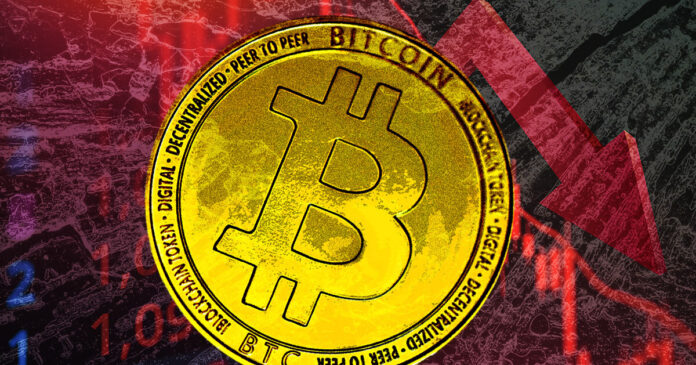Amid arguably the coldest winter in Bitcoin’s history, its price has fallen by more than 70% from its Nov. 10, 2021, all-time high of $69,044.77, while its market cap is down to $318.943 billion from the yearly high of $902.04 billion — a 64.64% decline.
Let’s take a look at some metrics that can provide more insight into the current Bitcoin bear market:
Transfer Volume Momentum
Before June, the 30-day Moving average (DMA) (red line) transfer volume in BTC reached new highs, but after the Luna-Terra crash, it rapidly declined and now stands at new lows.

Transfer volume on the Bitcoin network provides an indication of the current level of network activity and the value that is being transferred in BTC and USD. This metric compares the monthly average (red line) transfer volume against the yearly average (blue line) to underline relative shifts in dominant sentiment and help identify when the tides are turning for network activity.
It is typical for the 30DMA to be below the 365 DMA during bear markets and vice versa during bull markets. Currently, the 30 DMA has fallen below the 365 DMA, indicative of declining network fundamentals and declining network utilization, according to data analyzed by CryptoSlate.
This indicates that momentum has evaporated in terms of chain transfer, which is concerning. It is also the largest discrepancy between the 30 DMA and the 365 DMA in over the last five years.
Bitcoin Reserve Risk
CryptoSlate’s on-chain analysis shows the Bitcoin Reserve Risk indicator has declined to an all-time low.

The Bitcoin Reserve indicator gauges the confidence level of long-term holders relative to the current bitcoin price. Reserve Risk is the ratio between the current price (incentive to sell) and HODL Bank. The HODL Bank metric represents the cumulative opportunity cost of holding the asset.
When Bitcoin prices reach record highs, Reserve Risk (the red zone) tends to be higher, reflecting a decrease in investor confidence.
Alternatively, a lower Bitcoin price and higher confidence mean lower Reserve Risk (the green zone) or an improved risk/reward ratio.
However, at current times, BTC reserve risk has fallen out of the green box for the first time in its history, showing a lack of confidence among investors.
Nevertheless, low Reserve Risk can signal relative undervaluation, which can be a lengthy and prolonged process.
Bitcoin Miner’s Revenue
Bitcoin miners’ revenue per day declined over one year and fell to new lows due to a weak market and increasing computational demands.

As a result, mining firms such as Core Scientific have filed for bankruptcy, and multiple miners are also suffering. In addition, according to a previous report by CryptoSlate, miners are selling their coins at the highest rate in the last two years, resulting in difficulty being adjusted negatively moving forward.
Meanwhile, BTC miner wallet balances have dropped to levels seen in January 2022, according to data analyzed by CryptoSlate.
Mark Mobius, the co-founder of Mobius Capital Partners, who correctly predicted the drop to $20,000 this year, believes bitcoin is not far from $10,000 having broken the technical support levels of $17,000 and $18,000.
If Mobius’ $10,000 call comes true, it will add more misery to the cryptocurrency market.
However, Bitcoin sentiment is not entirely bearish in 2022. For instance, the number of long-term Bitcoin holders hit an all-time high this year.
Credit: Source link





















 Bitcoin
Bitcoin  Ethereum
Ethereum  XRP
XRP  Tether
Tether  Solana
Solana  Dogecoin
Dogecoin  USDC
USDC  Cardano
Cardano  Lido Staked Ether
Lido Staked Ether  TRON
TRON  Chainlink
Chainlink  Avalanche
Avalanche  Sui
Sui  Wrapped stETH
Wrapped stETH  Wrapped Bitcoin
Wrapped Bitcoin  Stellar
Stellar  Toncoin
Toncoin  Hedera
Hedera  Shiba Inu
Shiba Inu  Polkadot
Polkadot  WETH
WETH  LEO Token
LEO Token  Bitcoin Cash
Bitcoin Cash  Litecoin
Litecoin  Official Trump
Official Trump  Hyperliquid
Hyperliquid  Bitget Token
Bitget Token  Uniswap
Uniswap  Pepe
Pepe  Wrapped eETH
Wrapped eETH  USDS
USDS  NEAR Protocol
NEAR Protocol  Ethena USDe
Ethena USDe  Aave
Aave  Aptos
Aptos  Internet Computer
Internet Computer  Ondo
Ondo  WhiteBIT Coin
WhiteBIT Coin  Monero
Monero  Ethereum Classic
Ethereum Classic  Cronos
Cronos  POL (ex-MATIC)
POL (ex-MATIC)  Mantle
Mantle  Render
Render  Dai
Dai  Bittensor
Bittensor  Algorand
Algorand 
